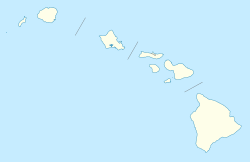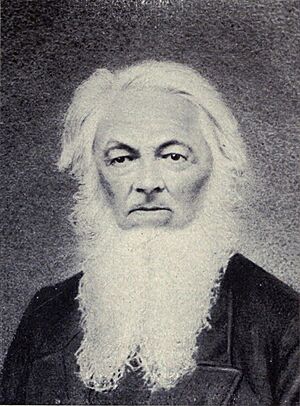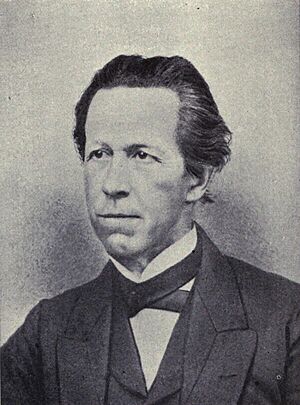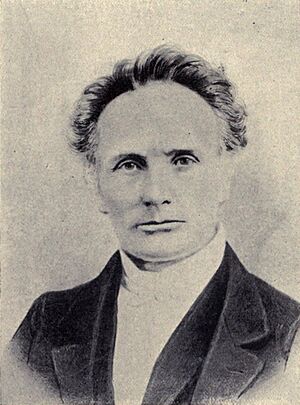Kahikolu Church facts for kids
Quick facts for kids |
|
|
Kahikolu Church
|
|
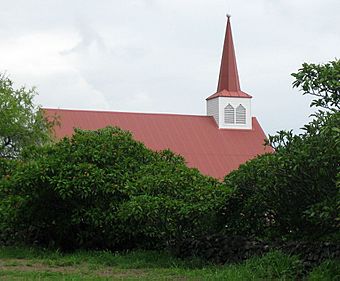
The restored church in use today
|
|
| Nearest city | Nāpoʻopoʻo, Hawaii |
|---|---|
| Area | 2.6 acres (1.1 ha) |
| Built | 1855 |
| Architect | John D. Paris |
| NRHP reference No. | 82000148 |
| Added to NRHP | November 15, 1982 |
Kahikolu Church is a special stone church built a long time ago, in the 1800s, on the island of Hawaii. It's one of only two churches like it from that time! It was built between 1852 and 1855. Before that, another church called Kealakekua Church stood in the same spot. That first church was built around 1833 in the Kona area.
Contents
Building the First Churches
In 1823, an English missionary named William Ellis traveled around Hawaii. He was looking for good places to build churches. He thought the village of Kaʻawaloa, near Kealakekua Bay, would be a great spot for one of the first churches.
In February 1824, a powerful leader named High Chiefess Kapiʻolani helped build a church. It was a thatched house in Kaʻawaloa village. Reverend James Ely and his family used it for Christian services.
Reverend Ely left in 1828. Reverend Samuel Ruggles took his place. Ruggles brought some coffee trees with him from the Hilo mission. These trees were important because they helped start the famous Kona coffee industry!
In 1833, Reverend Cochran Forbes took over from Ruggles. Forbes built a house higher up where it was cooler. In 1839, with Kapiʻolani's help, Forbes moved the mission. They went to the south side of Kealakekua Bay, to an area called Kepulu. This is near the village now known as Nāpoʻopoʻo.
Here, they built another house and a large church. This church was made of stone and coral lime. It was about 120 feet long and 57 feet wide. The Kealakekua Church was finished in 1841. It was used until 1845, when Forbes left because his wife was sick.
Building Kahikolu Church
For six years, there was no pastor at the church. Then, in 1852, Reverend John Davis Paris arrived. His family had been in Waiʻōhinu before. They returned to the United States and then came back to Hawaii. They were sent to the Kealakekua church.
Reverend Paris found the old church in ruins. He decided to build a stronger, but smaller, stone church. He built it on the same spot as the old one. This new church was called Kahikolu.
The name Kahikolu means "three in one" in the Hawaiian language. This refers to the Holy Trinity in Christianity. It also means it was the third attempt to build a church in this location.
The new church was about 57 feet by 62 feet. Its walls were very thick, about 35 inches! It took three years to build Kahikolu Church. It even had a bell given by William E. Dodge from New York. The church could hold about 1200 people.
Reverend Paris went on to build eight more churches. He passed away in the area in 1892. There are graves on both sides of Kahikolu Church. Some are unmarked. Others have the name "Kamakau," likely descendants of a chief named Kelou Kamakau.
Challenges and Restoration
In 1925, the inside walls of the church were covered with plaster. The ceiling and floor were also replaced.
In 1929, an earthquake caused part of the church's roof to fall inside. These parts were replaced with wood strips. Kahikolu Church used to be the biggest church on the west side of the island. But its importance lessened as people moved to other areas.
On August 21, 1951, a strong earthquake happened almost directly under the church. The roof collapsed after more earthquakes in 1952 and 1953. Because of all this damage, the stone church was left empty in 1953.
Kahikolu Church was added to the National Register of Historic Places on November 15, 1982. It was also added to the state list on July 30, 1982. The only other stone church from this time on the island is Mokuaikaua Church, about 12 miles north.
People worked hard to rebuild the church through the 1980s. The restoration of Kahikolu Church was finished around 1984.
In 1993, the body of Henry Ōpūkahaʻia was brought back to Hawaii. He was one of the first native Hawaiians to become a Christian. He is known for helping to bring Christianity to Hawaii. He had traveled from Hawaii to Connecticut in 1809 to study English and Christianity. He planned to return to Hawaii to preach, but he got sick and passed away in 1818 at age 26.
Ōpūkahaʻia's family decided to bring his body home from Connecticut. On August 15, 1993, his remains were placed in a special vault at Kahikolu Church. This church was the third one established in Hawaii by missionaries who were inspired by Ōpūkahaʻia. Hawaiian churches celebrate the third Sunday in February to remember him.
The church was fully restored and opened again for use in 1999. A historical marker was added in 2003.
Today, the church is located at 82-5931 Napoʻopoʻo Road, Captain Cook, Hawaii 96704. Sunday services are held at 9:30 AM, with Sunday School at 8:30 AM.
The Story of Kona Coffee
Remember Reverend Ruggles, who brought coffee trees in 1828? Those coffee trees grew very well in the area around Kealakekua, which is called the Kona District. Because this was the first coffee grown on the western side of the island, it is often called the first Kona coffee. Kona coffee is still very popular today!
See also
- Coffee production in Hawaii
- List of Missionaries to Hawaii


